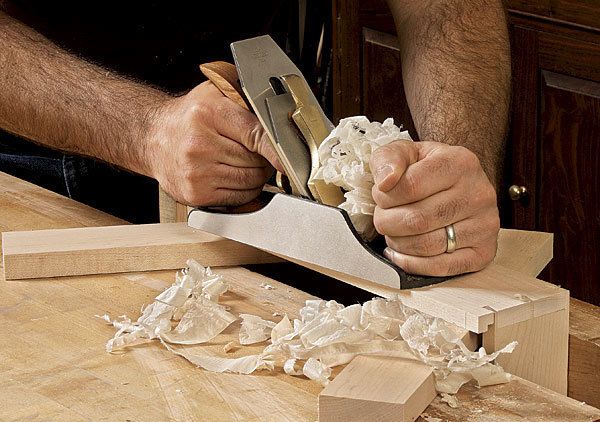Three Ways to Clamp a Drawer
Support the sides well, and you can plane them to fit without worry
Synopsis: To achieve the perfect fit between drawer and pocket that every furniture maker wants, you need to use a handplane—removing small amounts from each side of the drawer until it slides in and out beautifully with an even gap all around. But it’s not so easy to secure a drawer in your bench vise while handplaning. If you clamp it too hard, you can crack the side at the bottom groove. If you don’t clamp it hard enough, it will slip when you start planing. Here’s how two woodworkers solve this problem.
Fitting a drawer to its pocket is a precision operation, which is why the handplane is the go-to tool for the job. With it you can remove material from the sides methodically to achieve a perfect fit. However, to take whisper-thin shavings from a drawer side, you need to secure the drawer in a bench vise. With traditional drawers, where the back is narrower than the front, that task can be tricky.
If the vise clamps only on the drawer front, the drawer really isn’t stable enough to plane. If you clamp the drawer side between the vise jaw and benchtop, you’ll need a lot of pressure to hold the drawer steady enough for planing, and you run the risk of cracking the side at the bottom groove. However, if you back off on the clamping pressure, the drawer won’t be supported enough and will pivot down as you plane it.
Fortunately, there are some simple ways to improve your vise’s ability to clamp a drawer for planing, no matter what type of vise you have. The trick is to support the drawer from below. Doing so prevents it from pivoting down and allows you to grip the work with no danger of snapping the side.
A cast-iron vise attached to the front of the bench has a single screw and two guide posts to help control racking. Chris Gochnour uses those posts as a foundation for supporting the drawer. I use a twinscrew vise on my bench, and it doesn’t have guide posts. To support the drawer from beneath, I pass two narrow pieces of hardwood under the drawer side. On one end the sticks rest on the benchtop, and on the other end they rest on the vise jaw.
Gochnour also has a great technique for a planing a drawer without a vise. Why would you want to do that? Well, if you have several drawers to fit—such as for a chest of drawers or jewelry cabinet—you can quickly move from one drawer to the next with this technique. It’s just a matter of locking and unlocking a wedge between two supports. using a vise, you would need to adjust the jaw when you switched between drawers of different height.
For the full article, download the PDF below:
Fine Woodworking Recommended Products

Jorgensen 6 inch Bar Clamp Set, 4 Pack

Bessey K-Body Parallel-Jaw Clamp

Estwing Dead-Blow Mallet























Log in or create an account to post a comment.
Sign up Log in